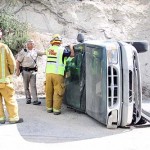The Gold Spotted Oak Borer continues its invasive spread northward from San Diego County. It is now found in both Orange and Riverside counties, infesting and ultimately killing coast live oak and California black oak.
GSOB-infested firewood is suspected to be the transportation agent, since beetle flight could not account for the significant distance jumps from points of infestation in San Diego County to Riverside and Orange counties locations.
The beetle, which has already killed 100,000 oaks in San Diego County, first reached Idyllwild in 2012. It was discovered in one tree on Highway 243 in Idyllwild’s downtown corridor. In the succeeding four years, GSOB spread has been gradual and relatively modest — to about 112 trees in Idyllwild and 15 on U.S. Forest Service land in the San Jacinto Ranger District. It reached Weir Canyon in Orange County in 2015 and currently infests more than 100 trees.
These figures are courtesy of Cal Fire/Riverside County Fire Division Chief Forester Greg Bratcher and John Miller, USFS public information officer.
Bratcher credits the slower spread on the Hill to the fact that Idyllwild has a mixed forest of oaks and conifers, in contrast to San Diego County’s concentrated oak woodlands. A varied forest acts to impede beetle flight, since oaks are not necessarily contiguous as they are in oak woodlands.
“In Idyllwild, GSOB spread has been gradual and in spurts,” said Bratcher. “If GSOB could make the jump [from Idyllwild] into the oak woodlands in Banning and Beaumont, the results would be catastrophic.”
Dr. Tom Scott, University of California, Riverside, adjunct professor, said statewide damage could be immense. “This may be the biggest oak-mortality event since the Pleistocene [12,000 years ago],” he said. “If we can keep firewood from moving out of the region, we may be able to stop one of the biggest invasive pests to reach California in a long time.
“Quarantines don’t work,” said Scott. “But enlightened self-interest could keep oak woodland residents from importing GSOB-infested firewood.”
But, regardless of the severity of the threat and a public education campaign against importing firewood, GSOB now infests more than 100 trees in Idyllwild and in Orange County — in the Weir Canyon Nature Preserve on the Irvine Ranch, north of Tustin and south of Anaheim.
Damaged trees can be identified by crown thinning, smaller leaves of less robust color, bark staining on the main stem, and D-shaped exit holes on the main stem and larger branches of the tree. According to the University of California Integrated Pest Management Program, trees with excessive crown thinning and dieback, and more than 100 emergence holes on the lower trunk, are considered severely infested and will die.
Current best practice is to remove severely infested trees to prevent GSOB spread to contiguous oaks. Prophylactic spray treatments can help prevent tree death on oaks that still appear healthy and where dieback evidence is less than 40 percent, according to latest research. “Spraying trees is not a one-time treatment,” said Bratcher, “because trees will continue to have hot spots.”
Bratcher noted, even with more than 100 trees identified as infested in Idyllwild, some landowners remain reluctant to permit inspection. “People are afraid Cal Fire will come out and remove their trees,” he said. But failure to remove severely infested trees will result in further GSOB spread, said Bratcher.
The farther north one goes in California, the greater the risk of massive GSOB damage. Riverside and Orange counties have relatively modest acreage in oak woodlands — 72,000 acres in Riverside County and 40,000 in Orange County. By comparison, San Luis Obispo County has 724,000 acres of oak woodlands and Monterey County has 921,000. San Diego County, where the beetle was first identified, has 320,000 acres in oak.
Currently, no financial assistance is available for removing infested oaks but Bratcher said there could be some coming. If you need further information or suspect your oaks are infested, contact the GSOB hotline at 951-659-8328 to arrange inspection.









